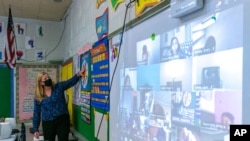For parents and teachers, navigating schooling during a global pandemic has proved to be a challenge. While many students returned to school online amid the COVID-19 pandemic, school districts across the country have reported double-digit declines among their preschool and kindergarten enrollment.
Public school enrollment across the Midwestern state of Missouri is down by more than 28,000 students. In Gaston County, North Carolina, the kindergarten population is down 16% from last year. Los Angeles Unified, the nation’s second-largest school system, lost nearly 11,000 pupils.
While there has been no comprehensive national data on the trend, research by NPR, in addition to independent news stations across the United States, points toward the coronavirus pandemic as the cause for the decrease in the number of the country's youngest students in public schools.
Portland Public Schools, the largest school district in the Western state of Oregon, reported a decrease in enrollment of 3% overall, with a 17% drop in the number of kindergartners.
Superintendent Guadalupe Guerrero told The Oregonian that the drop is not surprising, given that distance learning is better suited to older students.
For many parents, in-person classes during the pandemic raised concerns about safety. But distance learning provides its own challenges, and some families have opted to transition to alternative education methods, such as private schools and home schooling. Other families, in states like Missouri and North Carolina, have declined to enroll their kindergarten-age children this school year, as parents are not legally required to enroll their children in school until first grade.
The trend apparently extends beyond income lines. A survey by the Education Week Research Center found that among some 400 school districts, more than half reported a decline in kindergarten enrollment. The findings were similar between low-income communities and more affluent neighborhoods.
The drop in enrollment may cause additional challenges for school districts themselves, as most public schools are funded by states on a per-pupil basis. This, on top of additional expenditures like masks, hand sanitizer and boosted technology services, could leave U.S. schools scrambling for financial support.









